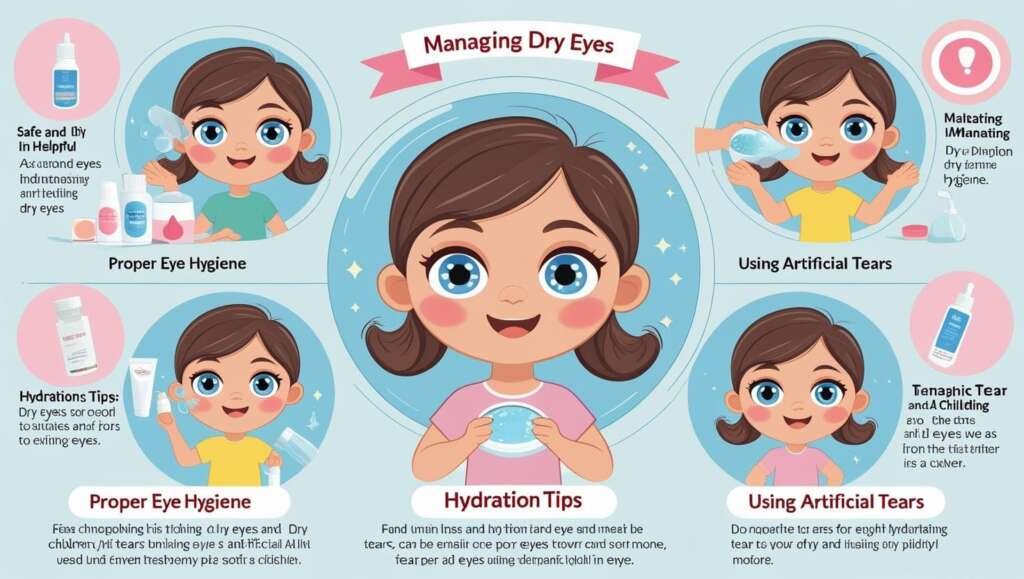In an age where screens have dominated our children’s lives, eye comfort has never been more critical. We all know that kids are often glued to tablets, computers, and TV screens, and parents usually notice dry eyes as a result. This frequently ignored condition can be uncomfortable and distracting day or night. Keeping kids’ eyes from getting too dry is essential for both their comfort and their health. Here, we will explore practical strategies for keeping kids’ eyes comfortable, allowing them to engage without irritation or dryness. Let’s get started.

Causes of Dry Eyes in Kids
Understanding the causes of dry eyes in children is essential for effective management. Here are some key factors that contribute to this discomfort:
Screen Time Overuse
Children mostly spend more time than ever on screens. Excessive use of tablets, smartphones, and computers often leads to reduced blinking, a crucial activity for maintaining eye moisture.
Environmental Factors
Dry air, whether from heating systems, air conditioning, or outdoor conditions, can impact eye moisture. Wind, smoke and pollutants can make dryness worse.
Allergies
Many children have seasonal chronic allergies that can contribute to eye irritation and dryness. Pollen, dust mites, and pet dander are common allergens that can cause frustrating symptoms, impacting their quality of life.
Underlying Health Conditions
Certain health conditions, such as autoimmune disorders or vitamin A deficiency, can lead to dry eyes. Insufficient nutrients can block tear production.
Contact Lens
For older children who wear contact lenses, improper use or hygiene can lead to dryness. It’s easy and convenient to buy contact lenses online, especially from trusted stores like Feel Good Contacts. You’ll find top brands, competitive pricing, and fast delivery—all without leaving your home. If you don’t follow care instructions or wear lenses for an extended time, it can increase the problem.
Common Dry Eye Symptoms in Kids
Being aware of the symptoms of dry eyes in children is essential for early intervention. Here are some key signs to look out for:
Frequent Eye Rubbing
If your little one is constantly rubbing their eyes, they may be experiencing discomfort or irritation. This may be a reaction to dryness and is worth pursuing.
Redness or Irritation
Red, inflamed eyes are a common sign of dryness. If you notice the whites of their eyes appearing more pink than usual, it could be a signal that they need relief. This is especially important for children who wear daily contact lenses, as improper use or extended wear can exacerbate redness and irritation.
Complaints of Burning Sensation
Kids might complain that their eyes feel full or burning. Unfortunately, the discomfort may contribute to feeling unable to concentrate on tasks or enjoy anything.
Excessive Tearing
Dry eyes can sometimes lead to excessive tearing. This paradoxical response occurs when the eyes produce tears in reaction to irritation but these tears are often not sufficient to provide relief.
Blurry Vision
If your child gets blurry visions or feels photophobic, then it is an overt reflection that there is no lubrication in the eyes. These signs may interfere with their day-to-day life.
Tips to Prevent and Manage Dry Eyes in Children
Taking proactive steps can help prevent and manage dry eyes in children. Here are some practical tips:
Limit Screen Time
Promote the 20-20-20 rule when it comes to limiting screen time: Every 20 minutes, have your child focus on something 20 feet away for 20 seconds. This habit helps prevent eye strain and encourages regular blinking.
Encourage Blinking
Encourage your kids to blink while they’re doing activities, mainly while concentrating on screens or reading. This can prevent their eyes from drying out.
Use Humidifiers
Adding moisture to dry indoor air can be beneficial, especially during winter months when heating systems can dry out the atmosphere. A humidifier can help maintain a comfortable environment.
Protect from Wind & Sun
Wind and UV protection are essential, so make sure your child wears sunglasses when outside. This barrier can help to keep skin from getting dry and irritated.
Stay Hydrated
Encourage your toddler to drink water throughout the day. Maintaining hydration is crucial for good eye health and optimal tear production.
Avoid Allergens
Opt for hypoallergenic soaps and shampoos to reduce irritation around the eye area. This one can help decrease the allergic reactions that cause dryness.
Safe Treatment Options to Alleviate Eye Dryness
If your child is experiencing dry eyes, there are several safe treatment options to consider:
Artificial Tears
Immediately start child-safe artificial tears that are preservative-free, which can offer quick relief from dryness. These are eye drops designed to help lubricate your eyes, which can be used as needed throughout the day.
Warm Compresses
Warm compresses may be helpful, particularly in children with retained oil glands. This technique may also open up the orifices of the glands and augment tear quality. Before starting treatment, consult a doctor.
Eye Drops
For effective relief from irritation and dryness, consider using eye drops like Hycosan Extra. These preservative-free drops are designed to provide long-lasting moisture and comfort for dry eyes. They can help soothe the symptoms and protect the eye surface, making them a valuable option for children.
Omega-3 Supplements
Omega-3 supplements are associated with maintaining healthy eyes. By all means, if you are considering supplements, make sure to check with your paediatrician for your child.
Consult an Eye Doctor
If your child continually complains of these symptoms, worse yet, their experience has deteriorated, a visit to an eye doctor is critical. They can conduct a comprehensive assessment and recommend treatments tailored to the child’s specific needs.
Conclusion
Dry eyes in a child can be not only uncomfortable but also life-altering. Early intervention can prevent long-term issues. Parents can monitor their child’s typical behaviors, such as screen time, and the environment in which they live. Look for dryness symptoms. If you have persistent or worsening symptoms, consult an optometrist.


